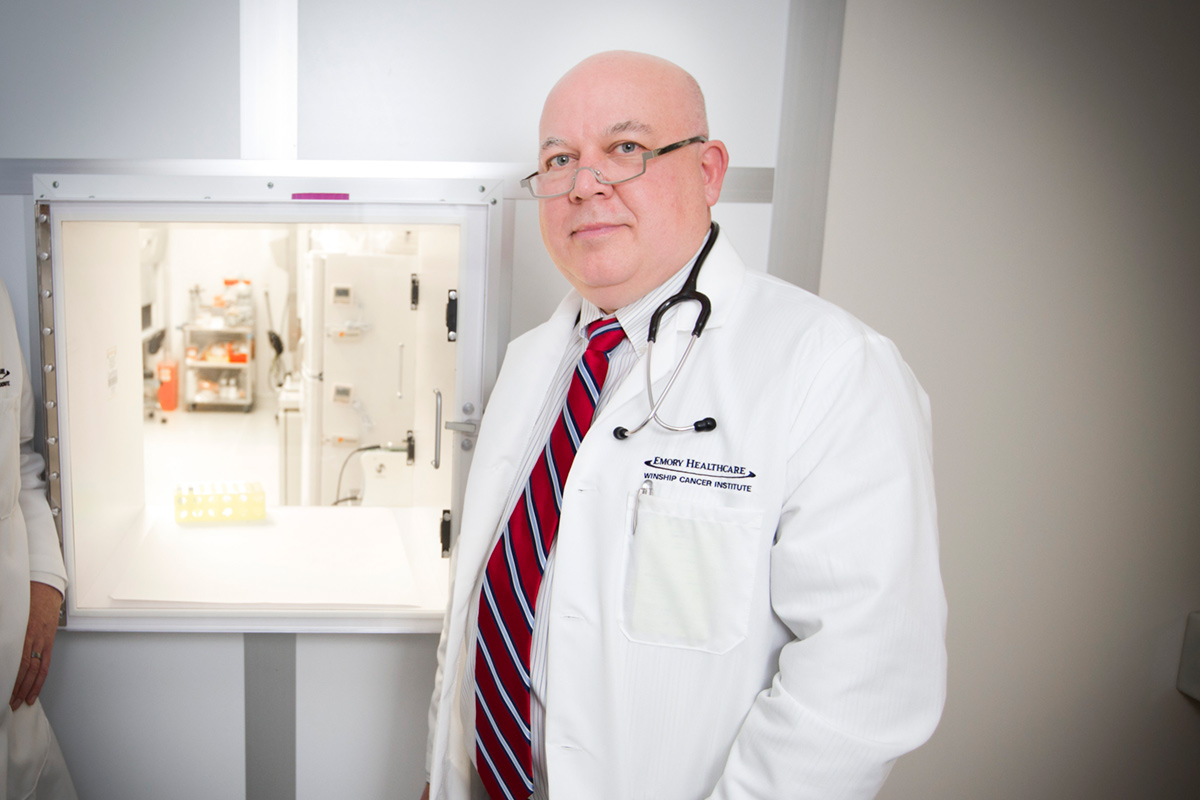Putting Heads Together
New ImmunoEngineering Consortium supports Emory, Georgia Tech collaboration to improve health

Billy Howard
After the brain, the immune system is the most complex system in the human body. When it works correctly with wondrous efficiency, as it does thousands, even millions, of times every day, invading disease-producing bacteria, viruses, parasites, and fungi don’t stand a chance.
But when things go wrong—the immune system is overwhelmed, or overreacts and attacks the body’s own cells—the results can be catastrophic.
In an ambitious effort to learn how to better regulate the immune system and effectively treat immune-related diseases and inflammation, researchers from Emory and the Georgia Institute of Technology have established the Georgia ImmunoEngineering Consortium.
“In terms of health and wellness in general, almost everything is related in some way to the immune system,” says Ignatio Sanz, who cochairs the consortium’s steering committee. “Infections, vaccines, autoimmune diseases, cancer, transplantation—all these and more are heavily dependent on the immune system.”
The consortium represents “a new way for Emory and Georgia Tech to explore important problems together and use engineering tools to better understand the function of the immune system,” says C. Michael Cassidy, president and CEO of consortium partner the Georgia Research Alliance (GRA), a nonprofit organization that expands the research and commercialization capacity of Georgia’s universities. “We think this represents a whole new world of disease management.”
The multidisciplinary consortium brings together engineers, physicians, chemists, physicists, computational scientists, immunologists, and clinical investigators to focus on an exhaustive range of illnesses: cancer, infectious diseases, autoimmune and inflammatory disorders, and areas of regenerative medicine including transplantation, bone and cartilage repair, and treatments for spinal cord injuries.
Emory’s Sanz is the Lowance Chair of Allergy and Immunology, director of the Lowance Center of Human Immunology, chief of the Division of Rheumatology in the School of Medicine, and a Georgia Research Alliance Eminent Scholar. He leads a team conducting research into understanding how B cells—the immune cells responsible for producing antibodies—go awry in autoimmune diseases such as lupus, rheumatoid arthritis, diabetes, and multiple sclerosis.
“We combine technologies such as multidimensional flow cytometry, deep sequencing of the B cells, generation of monoclonal antibodies, and computational biology to understand the type of B cells and antibodies responsible for autoimmune diseases,” he explains. “By learning about these issues, we will be able to greatly improve our ability to predict, diagnose, and treat autoimmune diseases in ways that are more effective and safer than current therapies.”
One such autoimmune disorder is Crohn’s disease, which is essentially an allergic reaction to one’s own large bowel. This chronic condition produces painful abdominal cramping, bloody stool, bowel perforation, and bowel obstruction, which often requires surgery.
Using adult stem cells, Jacques Galipeau, professor of hematology and medical oncology and director of the Emory Personalized Immunotherapy Center, is developing a treatment for Crohn’s that, if successful, may be adapted for other autoimmune disorders as well.
His approach works like this: A bone marrow sample is extracted from the patient and placed in a petri dish filled with a special nutrient broth. The tiny number of stem cells within the marrow sample multiplies exponentially, producing billions of new ones. These cells are then inserted into the patient through a series of injections during a period of weeks. This massive infusion of new stem cells dampens the overexuberant inflammatory responses causing the Crohn’s symptoms.
What distinguishes this technique, according to Galipeau, is that the new stem cells are derived from the patient, and they are fresh.

Jacques Galipeau
Bryan Meltz
“We’re the first ones in the world to systematically utilize fresh stem cells,” says Galipeau, noting that cells typically are harvested from random donors and frozen as a logistical matter before they are distributed to hospitals, thawed, and administered to clinical trial subjects.
“There’s nothing wrong with freezing, but the thawing process injures them,” he continued. “Not lethally, but they’re injured in such a manner that they lose all their immune-suppressive properties because they’re investing all their energy into surviving the thawing process.”
Another key factor is the material in which the stem cells are grown. Rather than use a liquid derived from cow’s blood, as is the norm, Galipeau has developed a nutrient made from human blood platelets.
Galipeau is working with pediatric gastroenterologist Subra Kugathasan on a clinical trial to test the therapy in advanced Crohn’s disease patients.
Pathology and laboratory medicine professor Max Cooper began searching for the roots of the human adaptive immune system by investigating primitive fish, but in the process he may have found a powerful new disease-detection agent.
Like all vertebrates, the jawless hagfish and sea lamprey are equipped with an adaptive immune system; that is, they produce cells that identify and destroy certain pathogens quickly because they “remember” a previous encounter.
“We found that they have basically the same type of lymphocytes as humans, but they use different genes and proteins to make antibodies,” Cooper explains. “They can make trillions of different kinds of antibodies, and while they see antigens a little differently than ours do, they are just as specific as our antibodies.”
The fish antibodies are smaller but sturdy, says the GRA Eminent Scholar, and are resistant to strong acids and alkalines. More important, “they can detect antigens and infectious agents like viruses, bacteria, and so forth very well. We hope to use them as cancer and infectious disease detection agents.”
Georgia Tech’s involvement in the Georgia ImmunoEngineering Consortium is based at its Center for Immunoengineering at the Parker H. Petit Institute for Bioengineering and Bioscience. There, engineering technologies are developed to assess, predict, and control immune response. The work addresses deficiencies in immune response as well as discovering ways to manage autoimmune diseases.
“Bringing engineers into health research is fantastic,” said Rafi Ahmed, a consortium cochair and director of the Emory Vaccine Center. Ahmed’s lab studies adaptive immune responses to vaccination and viral infection. The idea is to develop new and more effective vaccines by understanding the mechanisms of immunological memory—the ability of certain cells to remember previous encounters with pathogens and react quickly to destroy them.
“Engineers have different training and backgrounds, and they think about problems differently, so they bring a fresh, innovative perspective to biological questions.”
“There’s no way you can analyze a very complex system like the immune system unless you have people with different talents coming together,” he adds. “That’s why I think the Georgia ImmunoEngineering Consortium is such a terrific program.”



